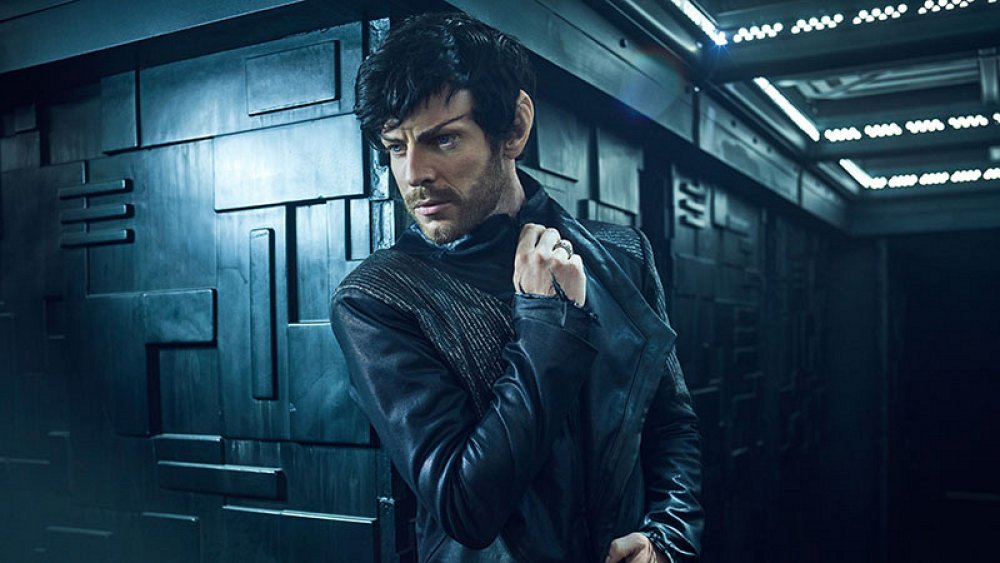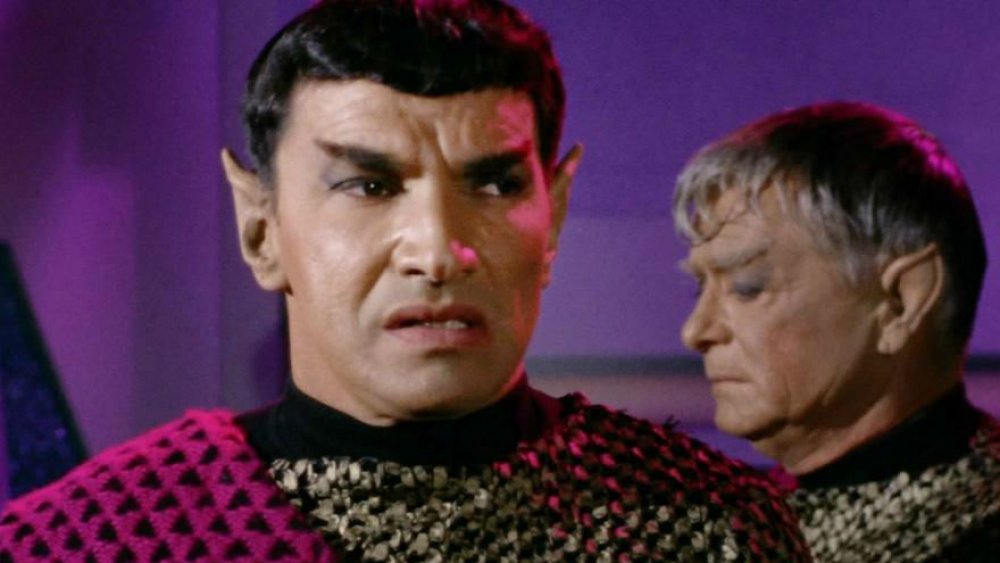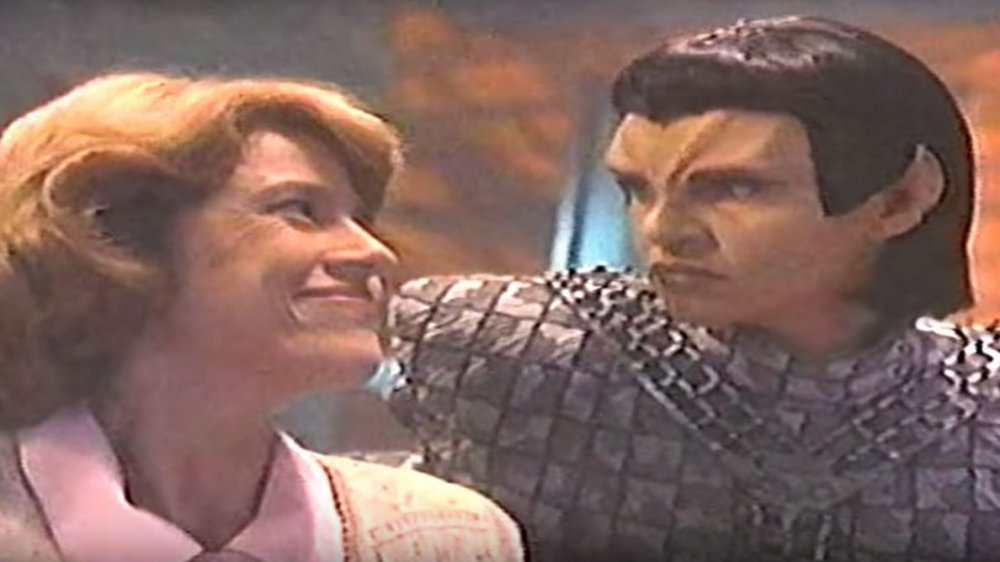The Untold Truth Of Star Trek's Romulans
Star Trek gives good bad guy. Since Star Trek: The Original Series' (TOS) premiere in 1966, Gene Roddenberry and his colleagues have brought us lots of memorable recurring antagonists. There are the warlike Klingons, the trickster Q, and the relentless Borg — but before most of Trek's repeat villains came the Romulans.
Only appearing in a few of the original series' episodes and making minor appearances in the original crew's films, the Romulans were nonetheless remembered when the Trek franchise was revived with Star Trek: The Next Generation (TNG). For most of their time onscreen, the Romulans have been Cold War-like opponents. They plot, they assassinate, and they threaten, but they rarely make open war on Starfleet. But when they do open fire? Well, nine times out of ten, the Romulans only let slip the proverbial dogs of war after their work in the shadows has made their victory seemingly inevitable.
Unlike Starfleet, the Romulan military and secret agents have few moral qualms about dealing with other species, and their mercilessness helps breed paranoia within their ranks. They'll do anything to get ahead, and assume everyone they meet is just as willing. Their paranoia sometimes proves more than accurate, as even some of the most idealistic members of Starfleet have taken a break from their usual ethical high ground when dealing with the sons and daughters of Romulus.
For more about one of Star Trek's oldest powers, keep reading for the untold truth of the Romulans.
Their creation was inspired by ancient Rome
According to commentary on the TOS season 1 Blu-ray, the idea for the Romulans came from writer Paul Schneider, who wanted worthy adversaries for Captain Kirk (William Shatner) and was inspired by the Roman Empire.
Romulans make their first appearance in the TOS season 1 episode "Balance of Terror." We learn that after a bloody conflict with the Romulans, a peace treaty was forged between them and the Federation via subspace radio. The treaty establishes a neutral zone in which neither side's ships are allowed to enter. A map is displayed to the Enterprise crew that shows the planets Romulus and Remus on the opposite side of the zone.
Romulus was the legendary founder of Rome. In Roman myth, Romulus and his brother Remus are born to a mortal woman, Rhea Silvia, who mates with Mars — the god of war. Left for dead by their uncle Amulius' servants, the twins are saved by a wolf. They're eventually raised by shepherds and, upon growing to adulthood and learning the truth about who they are, they kill their uncle and seek a place to start their own kingdom. There are different versions of how it happens, but at some point in the tale Romulus usually kills Remus in a dispute over where their new kingdom is to be founded.
Considering the treachery and violence we've seen the Romulans are capable of, if nothing else Schneider picked fitting names for their worlds.
Romulans are an offshoot of Vulcans
When the Enterprise first encounters Romulans, they're the first humans to actually see the race, and their physical similarities to Vulcans leaves some crew members questioning Spock's (Leonard Nimoy) loyalty. Their similar features aren't a coincidence — Romulans are an offshoot of the Vulcan species.
Centuries before the events of Star Trek when the Vulcans begin to purge their emotions in pursuit of pure logic, not everyone plays ball. Some Vulcans reject the new ideas, and after a bloody war they leave to create their own society on Romulus and Remus.
Romulans, however, are not just Vulcans on a different planet. Millenia of genetic drift created many subtle variations in their physiological makeup. They still share pointed ears, but there are some obvious differences, like the prominent ridges on Romulans' foreheads. There are less obvious differences too, which Dr. Crusher learns in the TNG episode "The Enemy," when she unsuccessfully tries to heal an injured Romulan by treating him as if he were a Vulcan.
Predictably there are Romulans like TNG's Sela (Denise Crosby) who feel nothing but contempt for Vulcans. But some feel a strong kinship toward their less passionate cousins. In the TOS episode "The Enterprise Incident," the Romulan Commander (Joanne Linville) admires and and is attracted to Spock. In the TNG two-parter "Unification," it's feared that Spock has defected to Romulus, when in fact he's there meeting the members of a growing movement of Romulans who wish to reunite with their Vulcan ancestors.
One of the first onscreen Romulans was Spock's dad... kind of
If you're more familiar with the original crew movies than with TOS, or more familiar with TNG, then you may be surprised to learn who played the first onscreen Romulan Commander: Mark Lenard, who would later appear in "Journey to Babel" as Spock's father Sarek. Lenard reprised the role of Sarek in TNG, in a number of the original crew movies, and even lent his voice to Sarek in Star Trek: The Animated Series. But before he played Sarek, he played the unnamed Romulan Commander in "The Balance of Terror."
Speaking to Starlog (via MyStarTrekScrapbook) in 1984, Lenard said the Romulan Commander role was the second time he'd gone up for a part on TOS. And while the second time proved the charm as far as getting on the series was concerned, it would take a third try before he got to meet any of the series regulars. In "Balance of Terror," all of the communication between his character and the Enterprise crew takes place on a viewscreen, so there was never any need for him to be in the same space. It wasn't until he returned as Sarek that he was able to meet the intrepid crew.
Lenard wasn't the only Romulan in that episode to return later as a Vulcan. Lawrence Montaigne, who plays the ambitious Romulan officer Decius in "Balance of Terror," returns as the Vulcan Stonn in season 2's "Amok Time."
The Romulans boast a number of secret cabals
One of the reasons so many Romulans remain loyal to their government is the Tal Shiar — a powerful secret police that conducts clandestine operations both inside the Romulan Empire and against Romulus' rivals. They kidnap, torture, assassinate, and don't lose much sleep over any of it.
The Tal Shiar is first mentioned in TNG but becomes more visible in Star Trek: Deep Space Nine (DS9), when we witness how resilient the organization is. In the two-part DS9 story spanning "Improbable Cause" and "The Die is Cast," the Tal Shiar join forces with the Cardassians' secret police — the Obsidian Order — in a sneak attack on the Dominion. The whole thing turns out to be a trap and their fleet is decimated. The events wipe out the Obsidian Order and help lead to the overthrow of the Cardassian government. The Tal Shiar, on the other hand, are still one of the most powerful parts of the Romulan government when we meet their leader Koval (John Fleck) in the DS9 season 7 episode "Inter Arma Enim Silent Leges."
More recently in Star Trek: Picard, we learn the Tal Shiar is a part of an older organization called the Zhat Vash — something so secret some Tal Shiar members believe it's a myth. The Zhat Vash is dedicated to wiping out all synthetic life, and it's embedded in governments all over the galaxy, including the highest ranks of Starfleet.
A favorite episode proves Starfleet isn't above using Romulan tactics
The Romulans are often depicted as unduly paranoid in contrast to the well-intentioned heroes of Starfleet. In a fan-favorite episode – DS9's "In the Pale Moonlight" — Starfleet proves that sometimes the Romulans should be paranoid.
Captain Ben Sisko (Avery Brooks) commits himself to convincing the Romulans to enter the war against the Dominion. He enlists the enigmatic Cardassian Garak (Andrew Robinson) to retrieve Dominion plans to invade Romulus. When that doesn't work out, Garak sells Sisko on the idea of creating a fake holographic record of the Dominion leaders discussing the invasion of Romulus. Sisko invites the Romulan Senator Vreenak (Joseph McHattie) to DS9 to show him the recording, but the senator sees through the lie. Not long after an enraged Vreenak leaves the station, we learn his ship has been destroyed and the Tal Shiar believes the Dominion is behind it. Sisko realizes Garak never meant for the fake holo-record to work, but instead always planned to assassinate Vreenak and pin it on the Dominion. Sisko is enraged and even attacks Garak in his shop, but in the end — because he's desperate to defeat the Dominion — he keeps the truth to himself.
The entire story is told from Sisko's point of view as he reads it into a log entry. In the final moments of the episode, as soon as he finishes the tale, he orders the computer to delete it.
Romulans make Star Trek's most famous beverage
Apparently, when Romulans aren't plotting to dominate the galaxy, they like to party. Sprinkled here and there throughout the Trek franchise is Romulan Ale — a very strong alcoholic drink that is illegal in the Federation, yet Starfleet officers keep getting their hands on it anyway.
The first time the beverage is mentioned is in 1982's Star Trek II: The Wrath of Khan when Bones (DeForest Kelley) brings a bottle of it to James Kirk for his birthday. Kirk is noticeably surprised at how strong the drink is. Regardless, he somehow doesn't have a problem serving it during a diplomatic dinner aboard the Enterprise in 1991's Star Trek VI: The Undiscovered Country — a detail that is used against him and McCoy when they're framed for assassinating the Klingon Chancellor. Ben Sisko serves what appears to be replicated Romulan Ale to a Romulan senator in the DS9 episode "In the Pale Moonlight," though the senator refers to it as "kali fal," which may or may not be the Romulan name for the blue drink. At the wedding reception for Riker and Troi in 2002's Star Trek: Nemesis, Worf (Michael Dorn) complains that "Romulan ale should be illegal" as he nurses a headache. "It is," Geordi (Levar Burton) reminds him.
As far back as the TOS episode "The Enterprise Incident," the Romulan Commander shares a blue drink with Spock as she's trying to seduce him, though we never hear its name.
In 1995, they wanted to wish you a Merry Christmas
In 1995, the Romulan Empire made its first appearance on a Hallmark commercial. No you didn't misread that. Promoting a Romulan Warbird Christmas ornament, Hallmark released a commercial depicting the pointy-eared aliens kidnapping a Hallmark cashier to interrogate her about how she'd "pirated" the design of the ornament from the Romulans.
And they didn't just get any actors to show up in costume and makeup. The cheerful cashier's interrogators are mostly Star Trek actors who had already played villains on at least one Trek series. Martha Hackett — the Romulan woman in the commercial — is probably more well known to Trek fans as the Cardassian Seska on Star Trek: Voyager. But she'd also played the Romulan officer T'Rul in the two-part DS9 episode "The Search." The introduction of the Defiant includes a cloaking device on loan from the Romulan Empire and it's T'Rul's job to run the cloaking device and keep its secrets from Starfleet.
Considering neither T'Rul nor any other Romulan is shown on board the Defiant to safeguard their cloaking secrets after "The Search," they apparently weren't any better about protecting their secrets than they are at interrogating Hallmark cashiers.
Romulans are in lots of first drafts, but fewer final drafts
When it comes to the Trek movies, the Romulans usually play second fiddle if they show up at all. Romulans were the chief antagonists of J.J. Abrams' 2009 Star Trek reboot, but before that they failed to take center stage in any of the movies. The closest they got was 2002's Star Trek: Nemesis; their homeworld and government are important to the plot, but the main villain is Shinzon (Tom Hardy) — a clone of Picard — and a race of former slaves called the Remans.
But it isn't for lack of trying. The Romulans were originally meant to take a larger role in a number of Trek films. Remember the Klingons in 1984's Star Trek III: The Search for Spock, led by the ruthless Commander Kruge (Christopher Lloyd)? According to a 2002 issue of Star Trek: The Magazine, it was originally going to be the Romulans who clash with the Enterprise in orbit of the Genesis planet — not Klingons. They were originally planned as the villains for 1998's Star Trek: Insurrection, but were ultimately replaced by the face-stretching Son'a. In Michael Piller's unpublished book Fade In, the Trek writer wrote that Patrick Stewart — among others — was very much against the inclusion of the Romulans, who the actor felt were "unexciting." Stewart worried that using the Romulans would make it appear as if "we just couldn't come up with any new bad guys."
The process of turning an actor into a Romulan has evolved
The look of the Romulans, the process of creating that look, and the resources devoted to it have all changed significantly since their first appearances. In TOS, Romulans look almost identical to Vulcans, and the cost of adding latex pointy ears to actors made them too expensive to use on background actors. On the TOS season 1 Blu-ray commentary, we learn that in "Balance of Terror," only two of the Romulan actors were actually given the ears while the rest of the Romulans are made to wear helmets hiding their ears.
Romulans show up a lot more once TNG comes around, and their reintroduction comes with a new design. Prominent brow ridges were added to Romulan prosthetics. According to the reference book Star Trek: The Next Generation 365, this was both to make the Romulans appear more menacing and to help differentiate them from their Vulcan cousins.
As of the 2020 premiere of Star Trek: Picard, hi-def technology changed things. On The Ready Room – the Picard after-show — prosthetic designer Vincent Van Dyke said that "every single background performer, all the way to the foreground hero characters" not only are fitted with ears, but "laced brows." Every single Romulan actor on Picard wears a prosthetic piece that includes eyebrows which have been painstakingly laced — one hair at a time — into the prosthetic. Long gone are the days of fitting the extras with skullcap helmets.
In Star Trek: Picard, the Romulans become both friends and foes
One of the unique things about Star Trek: Picard is that while it gives us plenty of Romulan villains, we also meet possibly the most sympathetic Romulan characters to ever appear in any Trek production.
When we find the retired Picard running his family vineyard, he's accompanied by two Romulans who treat him like nothing less than family. Laris (Orla Brady) and Zhaban (Jamie McShane) are former Tal Shiar agents who live with Picard, cook for him and — when a Zhat Vash squad comes gunning for the retired admiral — risk their lives for him. Their loyalty springs largely from Picard's efforts to evacuate the Romulan Empire. Both are fiercely protective of Picard, particularly Laris.
At the same time, the Romulans have not all left their more villainous impulses behind. Along with Picard's Romulan friends, the newer series introduces us to the seductive Narek (Harry Treadaway), his ruthless sister Narissa (Peyton List), and the fanatical Zhat Vash whose agents have the unsettling ability to spit out a corrosive liquid that kills both themselves and anyone unlucky enough to be nearby.
Star Trek: Picard forces 2009's Star Trek to make more sense
One of the interesting side effects of Star Trek: Picard and its stronger focus on the Romulans is that it manages to reach back in time and force 2009's Star Trek to make more sense.
A lot of fans — even those who enjoyed J.J. Abrams' reinvention of the Trek franchise — weren't overly impressed with Eric Bana's Nero. The Romulan villain goes into the past and, among other things, destroys Vulcan. Nero does what he does purely for vengeance, to get back at the Federation for the supernova that destroyed Romulus and killed his family. To some fans, Nero's motivations didn't add up. After all, the Romulan supernova is a natural phenomenon. How could Nero blame the Federation, the Vulcans, or anyone else for not helping, particularly when you consider how hostile the Romulans have been to, well... everyone?
But with Star Trek: Picard and the backstory it presents, Nero's quest for vengeance comes into focus. In Picard we learn that Starfleet committed to helping evacuate the Romulan Empire and then, after the unexpected synthetic revolt on Mars, backed out of the endeavor. From Nero's point of view, it's one thing to stand by and do nothing; it's quite another to offer help and then to withdraw it at the 11th hour. It makes Nero's rage much easier to relate to, though his actions are no less monstrous.











